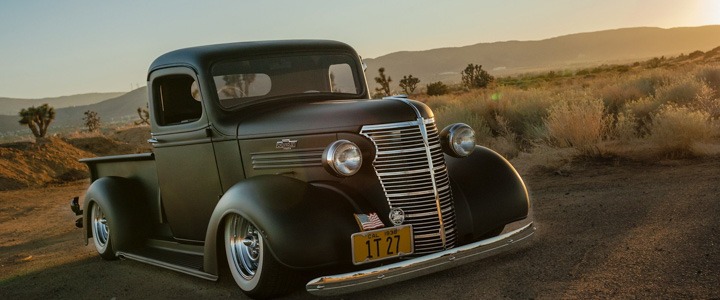
• From 1939 and up, the GMC six cylinder was a high pressure insert bearing engine – initially 228 and 248 cubic inches. Chevrolet trucks did not adopt the full insert bearing engine until 1954. This results in their similar appearing dash clusters with the of maximum oil pressure gauge reading of 80# for GMC and 30# for Chevrolet.
• Dark green was the standard exterior paint color. Most other colors, including black, were a non-cost option.
• The GMC with six-volt system uses a positive ground electrical system. Chevrolet uses negative ground.
• The GMC and Chevrolet pickups share bodies, most suspension, transmissions, etc. – not engines, grilles, tailgates, exterior colors or hub caps.
• In 1946 the 8 hole split rim was introduced on the 3/4 tons. Prior to this, the 3/4 tons used a heavier 6 bolt wheel than the ones on the 1/2 tons. These are often referred to as the artillery or scalloped type wheel.
• Early trucks were titled on either the body ID plate or engine number. If your title used the engine number and it has been replaced over the years, you may have major problems in selling or licensing.
• The famous Chevrolet high pressure 235 engine was used between 1954 and 1962. Its big brother, with some larger internal parts, was the 261 engine. A low pressure Chevrolet 235 was available on larger trucks only between 1941 and 1953. This earlier 235 has little in common with its later 235 relative.
• Whitewall tires were not available from the factory during these early years.
• The pickup running boards were black painted steel. The rubber covering was reserved for cars.
• Sealed beam headlights were first used on new trucks in 1940.
• The 4-speed transmission (optional on 1/2 ton) during these years is not synchronized. The driver must “double clutch” between shifts. The 3-speed was synchronized, but only in second and third gear.
• Electric wiper motors were not available from GM.
• The first year of the 1939-46 series had a different dash. Therefore, the 1939 glove box and windshield crankout assembly is used this one year only.
• These body style changes are grouped into the following years. 1934-36 high cab, 1936-38 low cab, and 1939-46.
• The right taillight was an option. Very few trucks had these dealer installed options.
• The Chevrolet 216 engine was used in both light trucks and cars between 1937-53. For the roads of the early years, they were great little engines!
• GMC began light truck production in 1936. Before this their primary market had been large trucks. With the “Great depression” GMC need to help sales!
• The pickup bed floors were oak until about 1940. From approximately 1941 until the last wood bottom stepside in 1987, the material was hard yellow pine. It was painted, not varnished. On at least 1946 and older the wood was painted black. Between 1941-1946, GMC pickups used metal bottom beds, not wood.
• During 1939-40, the Chevrolet 1/2 and 3/4 ton tailgate displayed its lettering in script style. The other years between 1934-46 had plain tailgates with no letters. GMC however, always used their logo on the 1936-46 tailgates.